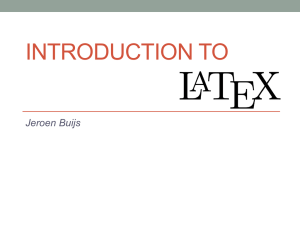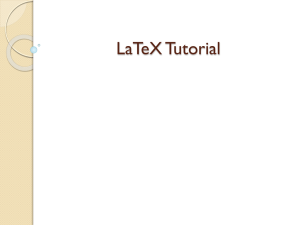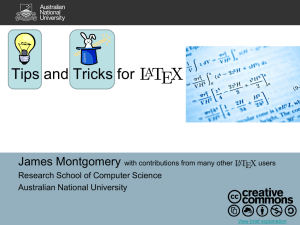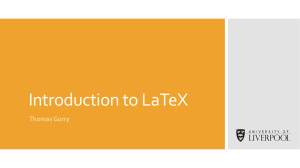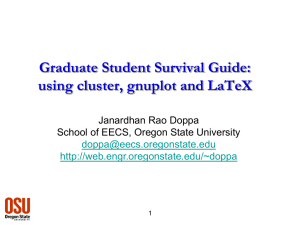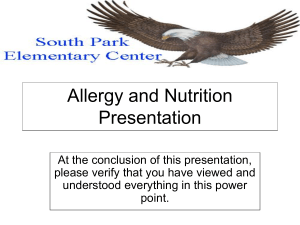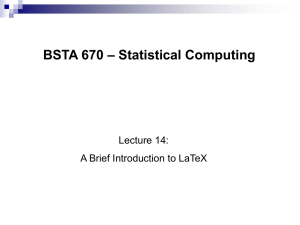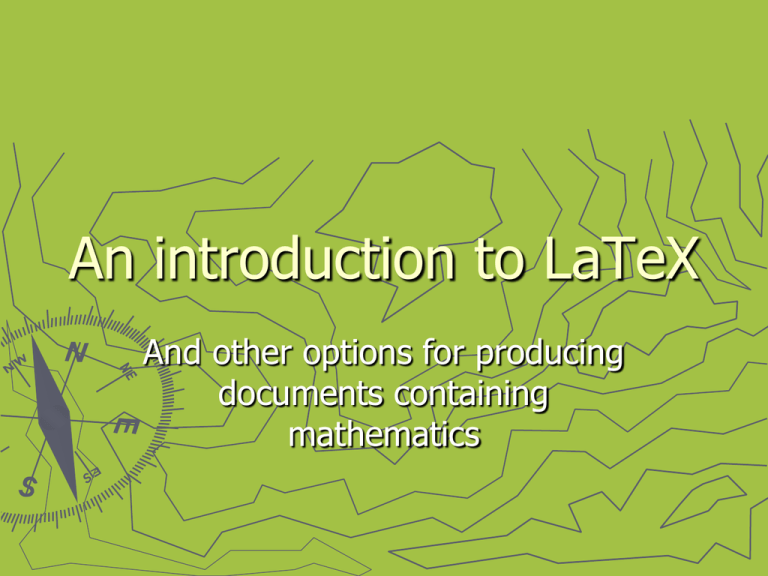
An introduction to LaTeX
And other options for producing
documents containing
mathematics
Robbie Robinson
Department of Mathematics
GWU
Washington DC 20052
robinson@gwu.edu
1. What is TeX?
Tex is:
►A
typesetting system for professional quality
scientific documents.
► ...especially those containing a lot of
mathematical symbols.
► Runs on multiple platforms.
► Comes in PlainTeX, LaTex, AMS-LaTeX, etc.
Origin
► Written
by Stanford University computer
scientist Donald Knuth.
► … was as unhappy about how publishers
typeset his papers,
► …studied traditional typesetting and
printing,
► …built a lot of expert knowledge into TeX.
Pronunciation
comes from Greek tec.
► Means both art and technology.
► Rhymes with “belch”….
► Does not rhyme with “sex”!
► However: LaTeX is sometimes pronounced
“lay-tex” (as in a type of rubber).
► Name
What does TeX consist of?
language and software.
► Knuth’s part TeX, plus packages (like LaTex)
► Knuth’s ultimate version of the TeX program was
►A
released in 1983.
► Knuth: “There will be no more changes.”
► The TeX Book (1986) ultimate TeX language
reference.
► Other Knuth books: on the program, fonts, etc.
2. LaTeX and other
packages
Ancient history & lagacy
is a primitive typesetting engine (by
Knuth) that is programmable.
► Programs can be put together into
packages.
► These define dialects and styles.
► With the final version of the TeX program,
Knuth released “PlainTex”, and the
“Vanilla” style.
► TeX
More history: AMS-TeX…
► Released
in early 1980's by AMS.
► Based on Knuth’s Vanilla style.
► Improvements:
handling very complex math formulas.
additional math oriented fonts.
► Developed
by Michael Spivak.
► The Joy of TeX (1982…)
Still more history: LaTeX…
► Released
in mid 1980’s
► written by Leslie Lamport, of Digital
Equipment Co.
► LaTeX: A documant preparation system
(1986)
► Upgrade of Knuth’s basic TeX language,
independent of AMS-TeX.
Innovations in LaTeX
► Automatic
numbering of theorems and
equations.
► A better “mark-up” system (e.g.,
environments).
► A Pascal-like style.
► A greater variety of document types
article,book, etc.)
► …still more fonts.
Current State of the Art
(Frank Mittelbach, et al)
► AMS-LaTeX as LaTeX-2e package.
► Knuth’s TeX program replaced with
PDFLaTex program.
► Easy to install distributions for Windows,
Mac, Linux (all open source).
► TeXworks GUI for all platforms.
► Many useful packages, styles, and auxiliaries:
► LaTeX-2e
BibTeX, graphics, Beamer, etc.
Distributions.
► Microsoft
Windows: MikTeX
http://miktex.org/ (use the “Basic Installer”).
► Mac
OS X: MacTeX
https://www.tug.org/mactex/
(install MacTeX.pkg).
► Linux
(or any Unix): TeX-Live
https://www.tug.org/texlive/
(It’s probably best to install via your Linux
distributions implementation of dpkg or RPM
rather than from here.).
GUI Front Ends
► TeXworks
(all platforms)
TeXShop (Mac), WinEdt (Windows)
► GNU
Emacs with AUCTeX package
(for the hardcore hacker in you…).
References
► More
Math into Latex by George A. Gratzer,
(4th ed 2007)http://www.amazon.com/More-Math-Into-LaTeXEdition/dp/0387322892
► Math
into LaTeX by George A. Gratzer (1993)
ftp://ftp.tex.ac.uk/tex-archive/info/mil/mil.pdf
►
LaTeX by Wikibooks.org
http://en.wikibooks.org/wiki/LaTeX
► TUG
(TeX Users Group)
https://tug.org
3. Using TeX
Mark-up
is a markup language, (like HTML,
the language of the www).
► You type an ASCII (text) file with the
extension ".tex”.
► You do not worry about formatting. You
leave it to LaTeX (as in HTML where you
leave formatting to the browser).
► TeX formats according to the style you are
using.
► LaTeX
Ideology
Document Design” as opposed to
“WYSIWYG” (what you see is what you get)
► Common to TeX and HTML.
► User describes logical role of each part of
the document.
► ... not how to place items on the page!
► “Logical
Of course some adjustment is often necessary
at the end…
Logical Document Design in TeX
► To
emphasize text, you type:
{\em Emphasize this!}
► What
you will (probably) get:
Emphasize this!
How do you demand italics?
{\it Italicize this!}
► What
you (should) get:
Italicize this!
Font control in La-TeX.
► {\bf
…
► {\rm …
► {\tt …
► {\sc …
}
}
}
}
for boldface,
for Roman (not italics or bold)
for teletype.
for “small caps”.
4. Typing Mathematics.
More TeX v.s. HTML
► In
TeX the big thing is mathematics.
Inside your document, all formulas are typeset
in math mode.
is display math and inline math.
►Variables in italics, numbers in Roman, lots of math
symbols!
►There
In contrast, text is set in text mode.
►Default
font is Roman.
Example
► Math
mode Inline: equations between $’s
An inline equation
$x^2-x-1=0$ appears in this line.
► You
will get (approximately)
An inline equation x2–x–1 = 0 appears in this
line.
LaTeX decides where to break lines, pages, etc.
Knuth’s poor choice of delimiters
► TeX
violates a common custom of notation:
Delimiters should come in left and right pairs.
$x^2-x-1=0$ violates this.
LaTeX corrects Knuth
Allows \( x^2-x-1=0 \) for inline math.
► But most people still use $x^2-x-1=0$.
► LaTeX also allows \[ x^2-x-1=0 \] for
display math.
► But I prefer a LaTeX feature called
►
environments:
Display equation environment in LaTeX:
Here is a displayed equation
\begin{equation} \label{eq:fib}
x^2-x-1=0,
\end{equation}
and it has a number.
Here is a displayed equation
(1.1)
x2–x–1 = 0,
and it has a number!
Later, you can refer to the label…
Solving the quadratic equation
(\ref{eq:fib}) we get the Golden
Mean.
Solving the quadratic equation (1.1) we get
the Golden Mean.
You can also display without a number…
Here is a displayed equation
\begin{equation*}
x^2-x-1=0,
\end{equation*}
without a number.
Here is a displayed equation
x2–x–1 = 0,
without a number!
Greek letters:
Spelled out as “control sequences”.
For all $\epsilon>0$ there exists
$\delta$ so that if $|x-y|<\delta$ then
$|f(x)-f(y)|<\epsilon$.
For all e > 0 there exists > 0 so that if
|x - y| < then |f(x) - f(y)| < e.
Subscripts and superscripts
These use “^” and “_”.
Nesting is allowed with {
}
Given a bounded sequence
$x_1,x_2,\dots$, there exists a
convergent subsequence
$x_{i_1},x_{i_2},\dots$.
Given a bounded sequence x1, x2,…, there
exists convergent subsequence
x i1 , x i2 ,... .
Integrals, and sums
If $f$ is in $L^2[0,1]$ and
\begin{equation*}
f_n=\frac{1}{2\pi}
\int_0^{2\pi} f(x)e^{i n x}\,dx
\end{equation*}
then $||f||^2_2=\Sum_0^\infty |f_n|^2$.
If f is in L2[0,2] and
fn
then ||
f ||
2
| fn |
n0
2
.
1
2
2
f ( x )e
0
inx
dx
Theorem-like environments
\begin{thm}\label{th:fw}
The equation $A^n+B^n=C^n$ has no
integer solutions for $n>2$.
\end{thm}
\begin{proof}
See the margins.
\end{proof}
Theorem 1.1. The equation An+Bn=Cn has
no integer solutions for n>2.
Proof. See the margins.
□
5. Document structure.
Starting and finishing
► LaTeX
requires (at least a few) special lines at
the beginning and end of a document.
\documentclass[12pt]{amsart}
\begin{document}
Put your text here...
\end{document}
Partitioning your document
\documentclass[12pt]{amsart}
\title{Hello world}
\author{Robbie Robinson}
\begin{document}
\maketitle
\section{Introduction}
Put your text here…
\section{The main result}
Put your text here…
\subsection{Some comments}
Put your text here…
\end{document}
Adding packages and macros
\documentclass[12pt]{amsart}
\usepackage{amsmath,amssymb,amsfonts}
\usepackage{graphicx}
…
\begin{document}
…
\end{document}
These packages ass fonts and symbols. And allow for
the insertion of graphics.
Adding Comments
\documentclass[12pt]{amsart}
\begin{document}
% Hi Steve. This is my latest draft.
% What do you think?
Put your text here…
\end{document}
Anything after a % on a line is a comment.
Other useful things to do
► Insert
graphics (pdf preferred, but can take
eps or bitmapped graphics too)
► Bibliography
Manually
With BibTeX
In LaTeX itself
► Index
or table of contents
All of the above are demonstrated
somewhere in the sample LaTeX files
6. The LaTeX workflow
The TeXworks window
Choose “Syntax Coloring” in “Format”
Choose “pdfLaTeX” and GO
Errors (need to be fixed)
(Finally) the result
Run twice or more
► LaTeX
is a 1 pass processor. Information
about cross-referencing, etc. requires a
second pass.
► With indexes, BibTeX bibliographies, etc.,
more passes may be necessary
► Errors and warnings. Take them all seriously
The perils of artificial intelligence
► LaTeX
(and TeX) “want” to do things their
way.
► As hard as it is to believe at first, their way
is usually better then your way (Knuth
studied 500 years of printing tradition).
► You can always force LaTeX to do what
you want, but it can be difficult to do.
7. Useful Programs
Now and on the horizon
Graphics
► Use
graphicx package (see examples)
► pdf, Posescript (vector graphics preferred)
Mathematica*, Maple*, Matlab* (Maxima,
Sage, Octave, Scilab, GNUplot)
Inkscape, llustrator*,ghostview, Acrobat*
► jpeg,
tiff (bitmapped)
Your camera or phone, web downloads,
Windows paint*
Photoshop*, Gimp, Irfanview (for Windows)
* = $$$ (these cost money)
Bibtex
► Supports
.bib format for bibliographic
citations.
► Entries downloadable from MathSciNet
(AMS math reviews online).
► References are automatically labeled.
► You can make master bibliography which
can be reused.
WYSIWYG
► Scientific
Workplace (Word, Notebook)
(commercial) http://www.mackichan.com
► LyX (open source) http://www.lyx.org/
► MathType (add on Math editor for Microsoft
Office)
► TeXpoint & MyTeXpoint (inset LaTeX in
powerpoint)
Beamer
►A
LaTeX alternative to Powerpoint.
(Not what I used here…)
► Can
include text, math symbols and
graphics. Some animation possible.
► Allows “easy” conversion between research
paper (in LaTeX) and research talk.
► See the examples…
8. The last word
Now and on the horizon
Advice
► Easy
to get started. With time, professional
results can be obtained. Be patient…
► Copy other LaTeX documents!
Using LaTeX is programming (hacking).
► Ask
professors or other students for help.
► Use Google/Bing search to find answers
(e.g., “LaTeX symbols”, etc.).
► Try things and see what happens….
Computer literacy for math
students
► LaTeX
including graphicx, BibTeX & Beamer
► Mathematica or Maple, and Matlab (if at all
applied) or free altenatives
Maxima and Sage; Octave or SciLab; Python
► Drawing
program like Inkscape (Illustrator)
► MathSciNet
► Linux and/or Unix (in addition to Windows,
MacOS, etc.)

